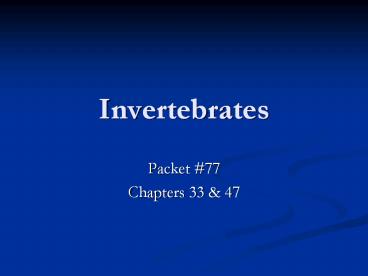Invertebrates PowerPoint PPT Presentation
Title: Invertebrates
1
Invertebrates
- Packet 77
- Chapters 33 47
2
Introduction I
3
Introduction II
4
Invertebrates- Animals Without Backbones
- Ninety five percent of all known animals species
are invertebrates. - Invertebrates have a worldwide distribution
ranging from deep sea hydrothermal vents to the
polar deserts of Antartica.
5
Invertebrates II
- Invertebrates can be separated into multiple
categories - Aceolomates
- The Sponges
- The Cnidarians
- The Flatworm
- Protostomes (Blastopore Mouth)
- The Roundworms
- The Segmented Worms
- The Mollusks
- The Arthropods
- Deuterostomes (Blastopore Anus)
- The Echinoderms
- The Chordates
- Tunicates
- Lancelets
6
ACEOLOMATES
7
The Sponges
- Phylum Porifera
- The Sponges
- Hermaphrodite, sessile animals
- They have no nerve or muscle tissue but
individual cells can react to environmental
changes.
8
The Cnidarians
- Phylum Cnidaria
- There are four classes of this phylum
- HydrozoaHydra
- CubozoaSea worms
- ScyphozoaJelly fish
- AnthozoaSea anemones
- Organisms have cnidocytes
- Organelles with stinging abilities
- Organisms have nerve cells that are irregular and
non-directional. - Occurs in two forms
- Polyps
- Medusa
9
The Flatworms
- Phylum Platyheminthes
- Most are hermaphrodites that are free living or
parasitic. - Organisms have sense organs and a simple brain
- Include tapeworms
10
PROTOSTOMES
11
The Roundworms
- Phylum Nematoda
- These organisms are normally associated with
being parasitic or pests. - Parasites
- Hookworms
- Pinworms
- Agricultural pests
- Attacking plant roots
12
The Segmented Worms
- Phylum Annelida
- Organisms have large compartmentalized coelom
that serves as a hydrostatic skeleton. - Includes the leeches and earthworms.
- Earthworms have setae which are bristles composed
of chitin.
13
The Mollusks
- Phylum Mollusca
- Soft bodied animals usually covered by a shell
- Organisms have a ventral foot, which is necessary
for locomotion, and have rasplike radula which
functions as a scraper in feeding. - Include squids, octopus, snails and slugs.
14
The Arthropods
- Phylum Arthropoda
- These organisms are segmented animals with
jointed specialized appendages. - The organisms have exoskeletons that are composed
of protein and chitin. - Include the centipedes, millipedes, lobsters,
crabs and insects.
15
DEUTEROSTOMES
16
The Echinoderms
- Phylum Echinodermata
- These are sessile slow moving animals that have
spiny skin. - Included are the sea lilies, sea stars, sea
urchins, brittle stars and sea cucumbers.
17
Phylum ChordataSubphylum Urochordata
- Tunicates
- Suspension feeding, marine animals with tunics
- Larvae have typical chordate characteristics
- Free swimming
- Adults of most groups are sessile suspension
feeders
18
Phylum ChordataSubphylum Cephalochordata
- Lancelets
- Small segmented, fishlike animals that exhibit
chordate characteristics
19
Characteristics of Common Animal Phyla
Phylum Sample Animal Acoelomate Pseudo-coelomate Coelomate Symmetry Number of Germ Layers
Porifera Sponge X Radial 2
Cnidaria Hydra X Radial 2
Platyhelminthes Planaria X Bilateral 3
Nematoda Roundworm Pinworm X Bilateral 3
Annelida Earthworm X Bilateral 3
Mollusca Slug Clam X Bilateral 3
Arthropoda Insect Spider X Bilateral 3
Echinodermata Starfish Sea urchin X Bilateral 3
20
REVIEW
21
Review I

